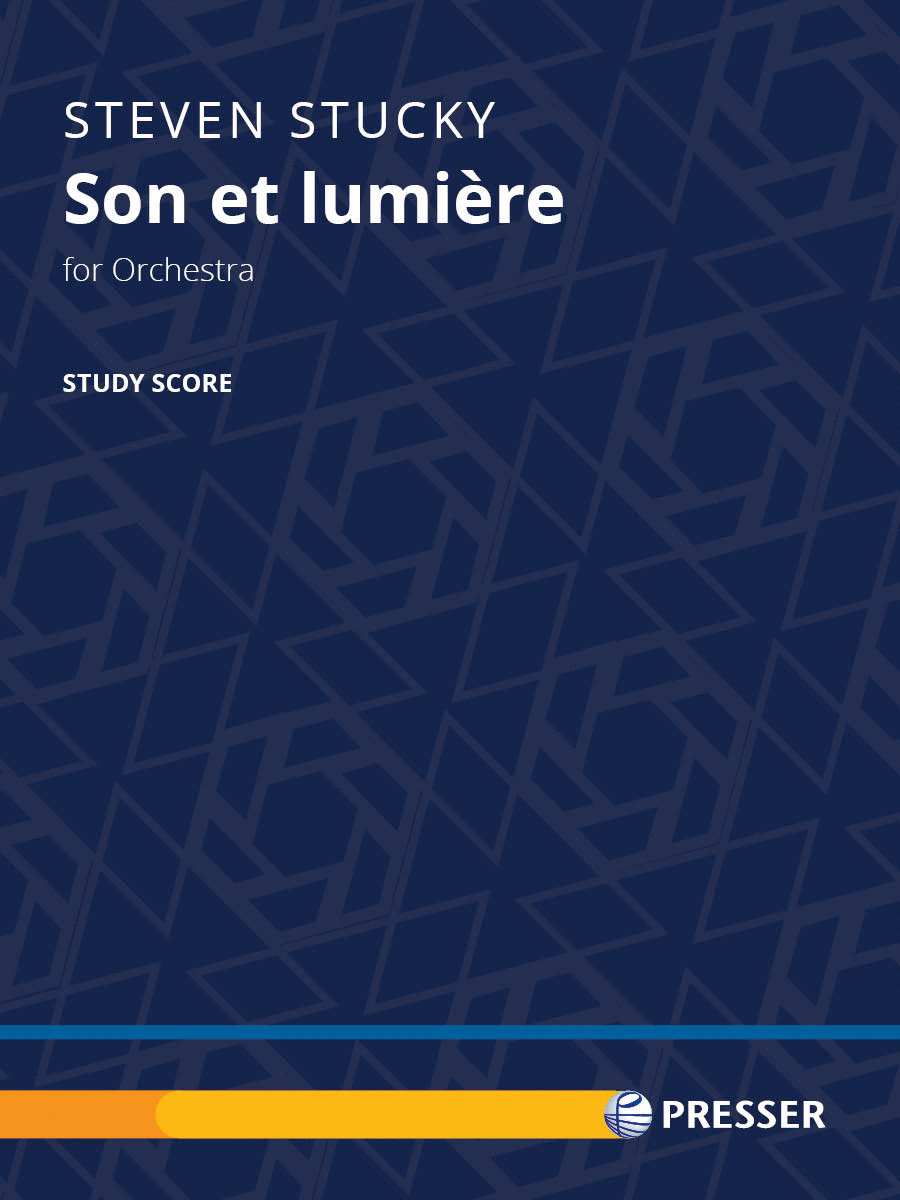Orchestra Bass Clarinet, Bass Drum, Bassoon 1, Bassoon 2, Celesta, Chimes, Clarinet, Clarinet 1, Clarinet 2, Claves, Contrabass, Contrabassoon, Cowbell, Crotales, English Horn, Glockenspiel, Harp, Horn 1, Horn 2, Horn 3, Horn 4, Maracas, Marimba, Oboe 1 and more.
SKU: PR.11641737S
Composed by Steven Stucky. Study Score. 68 pages. Duration 9 minutes. Merion Music #116-41737S. Published by Merion Music (PR.11641737S).
ISBN 9781491136133. UPC: 680160688432.
Son et lumière (“sound and light,” a kind of show staged for tourists at historic sites or famous buildings) is an orchestral entertainment whose subject is the play of colors, bright surfaces, and shimmery textures. I have tried in this music to recapture the élan and immediacy that regular meters and repetitive rhythms make possible—something forbidden during the modernist regime but recently restored in the post-modern work of composers like John Adams, Steve Reich, and others. Throughout its brief nine-minute span, then, the piece is built almost exclusively of short, busy ostinato figures—my attempt, I suppose, to achieve the rhythmic vitality of minimalism, but without giving in to the over-simple harmonic language that usually comes with it.Surprisingly, the musical materials seemed determined to shape themselves into an approximation of nineteenth-century sonata form. We hear an introduction, a first theme (based on triadic broken chords), a second theme (beginning with the flute solo), and a closing theme (led by two piccolos). In a sort of development section, these materials are recombined in new ways; in a recapitulation, both the first and second themes are recalled more or less intact (part of the second is actually repeated quite literally).Then, in the coda, a second surprise: as if another, different music has been lurking all the while behind the shiny surface, the strings now unexpectedly split off from the rest of the orchestra to assert a new, more passionate, more “serious” voice, transcending the external show of sound and light.Son et lumière, commissioned by the Baltimore Symphony Orchestra, was composed between June and December 1988 in Ithaca (N.Y.), in Los Angeles, and at the artists’ colony Yaddo, in Saratoga Springs (N.Y.). David Zinman conducted the first performance in Baltimore on 18 May 1989; André Previn gave the West Coast premiere with the Los Angeles Philharmonic on 18 January, 1990.
Son et lumière (“sound and light,” a kind of show staged for tourists at historic sites or famous buildings) is an orchestral entertainment whose subject is the play of colors, bright surfaces, and shimmery textures. I have tried in this music to recapture the élan and immediacy that regular meters and repetitive rhythms make possible—something forbidden during the modernist regime but recently restored in the post-modern work of composers like John Adams, Steve Reich, and others. Throughout its brief nine-minute span, then, the piece is built almost exclusively of short, busy ostinato figures—my attempt, I suppose, to achieve the rhythmic vitality of minimalism, but without giving in to the over-simple harmonic language that usually comes with it.Surprisingly, the musical materials seemed determined to shape themselves into an approximation of nineteenth-century sonata form. We hear an introduction, a first theme (based on triadic broken chords), a second theme (beginning with the flute solo), and a closing theme (led by two piccolos). In a sort of development section, these materials are recombined in new ways; in a recapitulation, both the first and second themes are recalled more or less intact (part of the second is actually repeated quite literally).Then, in the coda, a second surprise: as if another, different music has been lurking all the while behind the shiny surface, the strings now unexpectedly split off from the rest of the orchestra to assert a new, more passionate, more “serious” voice, transcending the external show of sound and light.Son et lumière, commissioned by the Baltimore Symphony Orchestra, was composed between June and December 1988 in Ithaca (N.Y.), in Los Angeles, and at the artists’ colony Yaddo, in Saratoga Springs (N.Y.). David Zinman conducted the first performance in Baltimore on 18 May 1989; André Previn gave the West Coast premiere with the Los Angeles Philharmonic on 18 January, 1990.
Publisher : Merion Music$45.00 - See more - Buy online
 (AMERICAN COMPANY)
(AMERICAN COMPANY) 